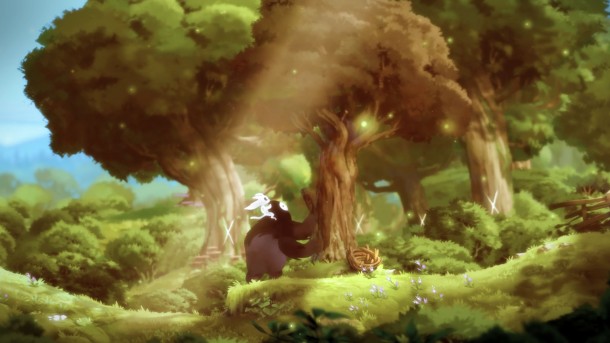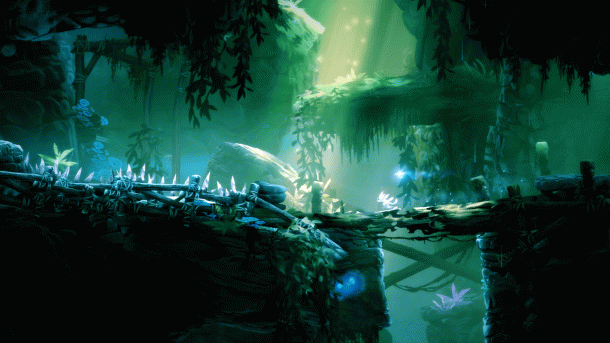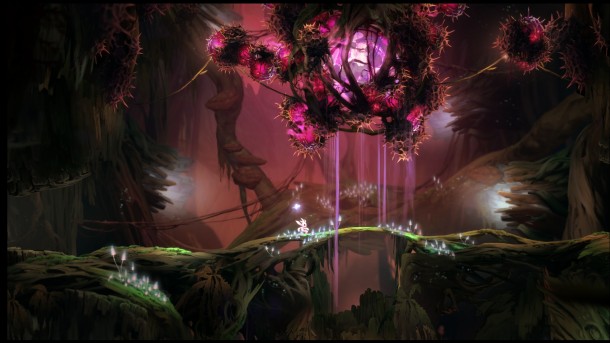The indie scene has no shortage of side-scrolling Metroidvania platformers, so I’ll admit that I was skeptical when I started to hear people talk about Moon Studios’ Ori and the Blind Forest with a type of reverence usually reserved for the established players in the genre. Still, I found it hard to resist the allure of a half-way decent platformer, and so with tempered enthusiasm I decided to give it a run. I spent the next 8 hours on a roller coaster of a ride that was hard to step away from once it got going.
Ori uses a pretty effective hook early on, telling an emotional story of a creature (named Ori!) who is nursed to life by a stranger after a brush with death. Ori grows fond of his new friend, with early gameplay involving the interaction between these two characters. As these stories are wont to do though, things don’t stay idyllic, and tragedy befalls the land. I won’t rob the game of its emotional impact, suffice to say that you will eventually gain control of Ori on a quest to try and restore normalcy in a world suddenly ravaged by elemental chaos. The disembodied voice that will occasionally narrate parts of the story is a little jarring, and the story itself isn’t anything that hasn’t been told before, but it’s enough to drive early motivation. And that’s all it needs, because once the platforming starts picking up speed, you no longer need the story to keep you playing.

Platformers live and die with the controls. Too simple and you turn off the hardcore audience; too hard and it becomes inaccessible to a larger audience of casual gamers. Ori does a good job of gating your progress, compartmentalizing new skills, spacing them out and for the most part ensuring you have mastered each new ability that Ori picks up along the way before throwing the next new trick at you. You will often see shiny objects that are out of reach and are challenged to revisit these areas later once you have the means to reach them. Double jumps, wall climbing, dive stomps and much more will become part of your skill arsenal. One of the more unique abilities you’ll pick up allows you to latch on to an enemy or projectile while freezing time momentarily and choosing a direction to launch yourself (all while pushing the object you’re latched to in the opposite direction). This move can be chained together endlessly, allowing you to traverse entire areas without hitting the ground. Of course, with each new skill comes an increasingly complex control set. I did have to refer to the control scheme when I came back to the game, as I had forgotten some of the skills I had and needed to use one of them to progress in an area. That said, Ori never felt unmanageable, even when all the skills were at my disposal.
Actually controlling Ori is satisfying as well. Controls are tight and responsive, without being overly so for the most part. One minor exception to this involved climbing up the side of moving platforms; it was often difficult to stop Ori from climbing over the top, and when you did, it was also difficult to properly position yourself where you wanted on narrow platforms. That aside, Ori will glide around the world with a graceful ease, and once you unlock mobility skills, you can chain together impressive combinations of movement and attacks to great effect.
Ori isn’t all just moves, of course. Attacks are executed through a glowing guide (Sein) you will encounter early in the game — think Navi without the “HEY, LISTEN”. Sein will hover to nearby enemies, allowing you to execute basic attacks by mashing the attack button, or (later) power attacks by charging the attack button and releasing. These power attacks are controlled by an energy meter which can be refilled by items the drop from enemies and crystal formations found throughout the game. The same energy used for these attacks also can be used to save your game at any point. It’s worth repeating: you are in control of your own checkpoints, and must balance your energy use in order to take advantage of this. Summoning a save will also allow you to visit a character development menu that will allow you to further empower Ori through a series of passive ability improvements (increased damage, underwater breathing and triple jumps). These enhancements are earned by collecting experience through enemy drops, quest completions, and finding secret areas. My personal recommendation: find the passive ability that increases the amount of experience dropped from enemies, and get that first.

The game scales the challenge at what I felt is a very appropriate pace. You will die often in this game, but I never found it an overly frustrating experience. This is due in large part to the fact that you instantly return to your last checkpint within the game when you die. There’s no time to mull over your mistake in a loading screen, and there’s never an opportunity to get really pissed because the game just throws you back into the action. The only time you may really get upset is when you forget to drop a checkpoint and find you have to redo a few minutes of work, but even then you’re more pissed at yourself than the game. This is actually a bit of genius on the part of the developer, circumventing a common gripe of save points by giving the player the power to set them just about anywhere.
There are a few other surprises in store as you play, from a challenge perspective, but I do want to leave some of that for you to experience, so I won’t go into details. I will say that the game boils down to three main “dungeons” (each of which needs to be unlocked through a series of actions before you can enter them). One important thing to note is that you cannot go back to your game once you beat it, so once you feel you’re near the end (and you’ll know), completionists may want to backtrack and collect everything they left behind before beating the game. There’s also no New Game+ mode, or any real reason to go back to the world once you’ve beaten it, aside from one achievement that demands you beat the game without dying.
I’ve said nothing thus far of the visuals or sound, and it’s only because those are two elements of the game that are so noticeably wonderful from the start, they need almost no mention. The game is beautifully drawn, animations (particularly of Ori) are fluid and well done, and the music and sounds are equally fantastic. Nothing about the visual or aural art direction (narrator’s voice aside) will detract from your experience, and at times will significantly enhance it.

Ori and the Blind Forest is a beautiful, accessible platformer that will slowly ratchet up the challenge enough to satisfy all but the most hardcore. A plethora of skills and abilities keep gameplay engaging throughout, and level design is very good. There are parts that demand trial and error to figure out, but by giving the player control over checkpoint saves, much of the frustration is removed from those errors. In my opinion, this is a Game of the Year nominee. Don’t miss it.
This review is based on a copy of the game purchased by the reviewer


2 Comments